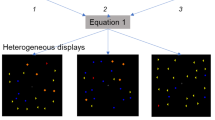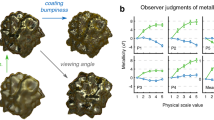Abstract
IF a circle, 2 cm. in diameter, is divided into quadrants and coloured as in Fig. 1, placed on either a black or white ground, and then viewed with one eye from a distance of about 3 m., it will be found that there is considerable difficulty in distinguishing the green from the light blue on one hand and the orange-brown from the light red-purple on the other, so long as the brightnesses of the fields are made as equal as possible. There will be no difficulty in distinguishing the green from the orange, provided that the observer is not red-green colour-blind in the sense that he habitually confuses such colours, and the circle will appear to be divided into two halves, right and left. Red-green colour-blind observers see the circle as uniform, or they may be able to separate the quadrants on subtle brightness differences.
This is a preview of subscription content, access via your institution
Access options
Subscribe to this journal
Receive 51 print issues and online access
$199.00 per year
only $3.90 per issue
Buy this article
- Purchase on Springer Link
- Instant access to full article PDF
Prices may be subject to local taxes which are calculated during checkout
Similar content being viewed by others
References
Pitt, F. H. G., Proc. Roy. Soc., B, 132, 101 (1944).
Willmer, E. N., NATURE, 151, 213 and 632 (1943).
Granit, R., Acta Physiol. Scand., 3, 318 (1942).
Author information
Authors and Affiliations
Rights and permissions
About this article
Cite this article
WILLMER, E. Colour of Small Objects. Nature 153, 774–775 (1944). https://doi.org/10.1038/153774b0
Issue Date:
DOI: https://doi.org/10.1038/153774b0
Comments
By submitting a comment you agree to abide by our Terms and Community Guidelines. If you find something abusive or that does not comply with our terms or guidelines please flag it as inappropriate.



